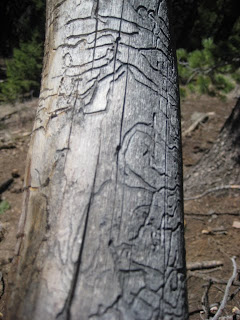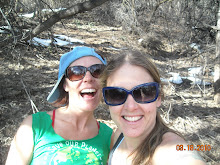Altitude Gained: 1290 ft.
High Point: 8680 ft.
yes, it makes a sound
when they fall and we're not there
trees are not alone
The Dry Fork Loop is an easy half day hike that joins up with a stretch of the Colorado Trail. Pixler and Peel have rated it as moderate, but we beg to differ. As a hike, it is so easy that it almost gets boring toward the end. It is quite long and the climb and descent are extremely gradual, even though we went up via Hoffhein's Connection, the allegedly "much steeper" way. We imagine that it is a fantastic bike ride as the traffic on the trail would suggest. We like a hike with a little more push, but this one's nice if you are looking to just take an arborary stroll.
We are always happy to pass an afternoon with the trees. We saw a diverse array of Colorado beauties: aspens, spruce, doug firs, a myriad of budding decidious and of course our good friends, the ponderosas. There is just something about these pines. They are engaged in some sort of cosmic dance that is blowing our mind. The ones on the Dry Fork trail seem to be even older and wiser than others we have seen.
They also seem to be more active so to speak. Some dance, others do yoga. And for some reason, this trail has an unusally high occurence of displaced trees. A fallen tree traverses the path every so often. Some of them look to have simply fallen over and others appear to have been ripped from the ground by an angry giant.
Ironically, the forces that bring these beasts down are of the microscopic variety. These majestic beings can fall victim to a number of destructive little terrorists: parasitic plants like the Dwarf mistletoe (Arceuthobium americanum), deadly root-fungi or Black stain root disease (Ophiostoma wageneri), and of course the hundreds of insect species that attack the ponderosa, most devestating are those in the Ips and Dendroctonus genuses; the beetles.
tunnels or galleries left in the underbark of a Ponderosa
by adults and larve of Dendroctonus ponderosea.

The Aspens are a major presence in these parts too. Last year's leaves make a patchwork quilt across much of the trail.
But seriously, what causes a tree to grow like this? At what point in its 300-600 year lifetime does the ponderosa pine start vogueing? Do they just get bored some decades and decide to stretch their branches in a new direction? Seriously, if any can explain this to us...
What characters!
This photogenic Green Comma (Polygonia faunus) butterfly danced with us a moment before graciously posing for this glamour shot. These brush-footed butterflies are easy to identify because of their ragged wing edge and the thick dark borders with little yellow spots. Their flickering bursts of color make the forest feel a little more enchanted.
From out of nowhere, this mysterious game bird scurried across the ground and fluttered up into a pine tree to hide. It looked a bit like a chicken and had a strange tessalated pattern on its underbelly and hindwings and a distinct crest on its tiny head. Our most educated estimation is that it is a Scaled Quail (Callipepla squamata), definitely not an ave that we expected to see.
As suggested by Pixler and Peel, we took a short detour east down the Colorado Trail to Gudy's Rest, a scenic stop memorializing Gudy Gaskill, one of the pioneers of the trail. It is a nice resting point, and it gets a hiker to thinking about the sheer marvel of the Colorado Trail, a 475 mile footpath from Durango to Denver. The trail is including in Hiking Trails, and although we don't anticipate getting to it this season, it is on our list of things to do (and blog about).
















i don't think trees decide anything. their form is caused by gravity and weather acting on them.
ReplyDeleteokay, explain a gravity or weather situation that would cause the branches to form at perfect right angles.
ReplyDeleteI love dry fork trail because my five year old can hike all the way to the fantastic nettles patch and back!
ReplyDeleteDo you think that bird is perhaps a grouse? It's shadowy outline suggests.